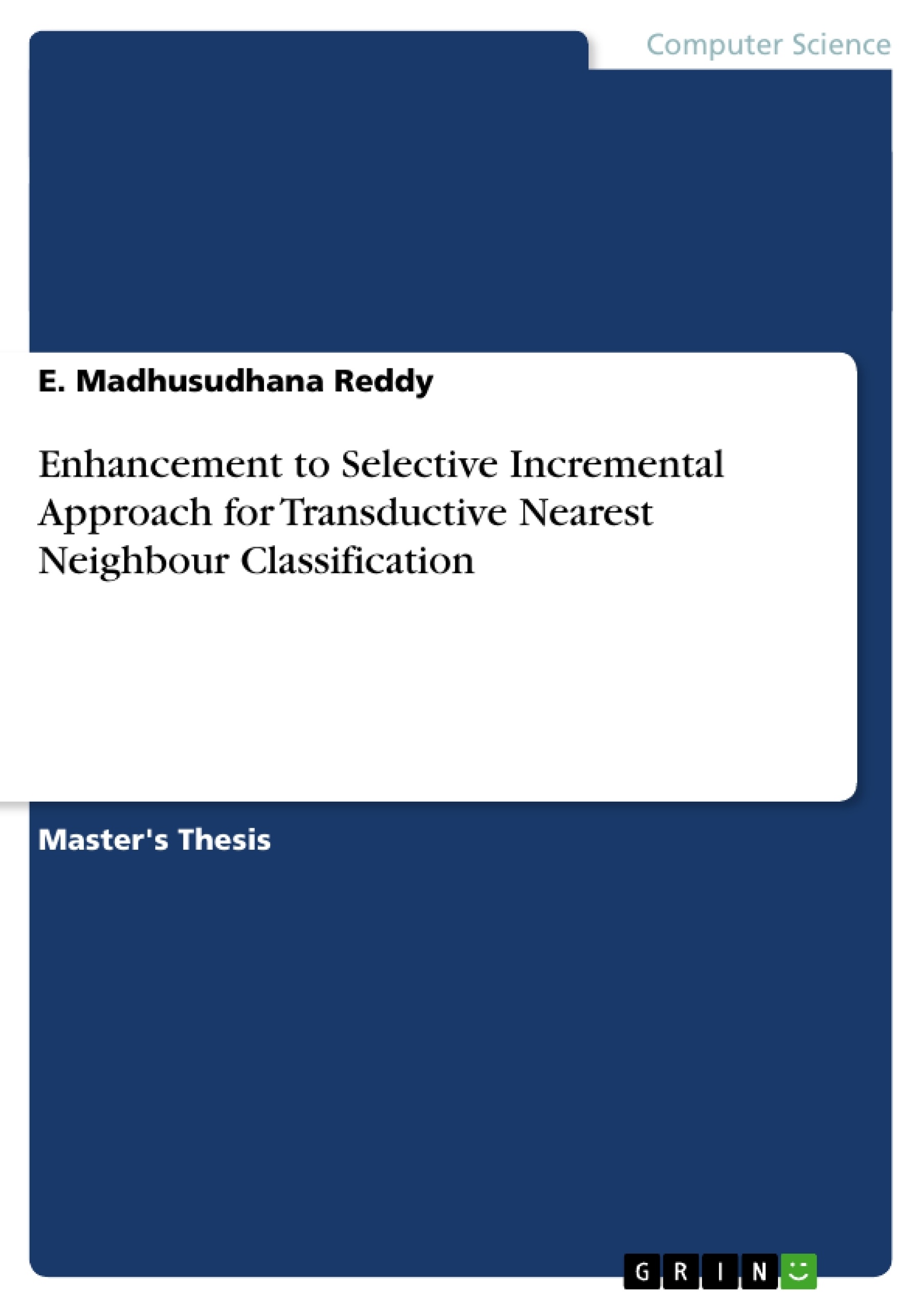During the last years, semi-supervised learning has emerged as an exciting new direction in machine learning research. It is closely related to profound issues of how to do inference from data, as witnessed by its overlap with transductive inference. Semi-Supervised learning is the half-way between Supervised and Unsupervised Learning. In this majority of the patterns are unlabelled, they are present in Test set and knowed labeled patterns are present in Training set. Using these training set, we assign the labels for test set.
Here our Proposed method is using Nearest Neighbour Classifier for Semi-Supervised learning we can label the unlabelled patterns using the labeled patterns and then compare these method with the traditionally Existing methods as graph mincut, spectral graph partisan, ID3,Nearest Neighbour Classifier and we are going to prove our Proposed method is more scalable than the Existing methods and reduce time complexity of SITNNC(Selective Incremental Approach for Transductive Nearest Neighbour Classifier) using Leaders Algorithm.
Inhaltsverzeichnis (Table of Contents)
- Chapter 1: Machine Learning - An Introduction
- 1.1 Introduction
- 1.2 Data mining and Machine Learning
- 1.3 What is Machine Learning?
- 1.3.1 What is learning?
- 1.4 Learning Strategies
- 1.5 History of Machine learning
- 1.5.1 Early enthusiasm (1955-1965)
- 1.5.2 Dark ages (1962-1976)
- 1.5.3 Renaissance (1976-1988)
- 1.5.4 Maturity (1988-Present)
- 1.6 Applications of Machine Learning
- 1.7 Typical Taxonomy of Machine Learning
- 1.7.1 Supervised learning
- 1.7.2 Un Supervised Learning
- Chapter 2: Semi Supervised Learning
- 2.1 Introduction to Semi Supervised Learning
- 2.2 Semi Supervised Learning
- 2.2.1 Semi Supervised Classification
- 2.2.2 Semi Supervised Clustering
- 2.2.3 Semi Supervised Feature Selection
- 2.3 Generative Models
- 2.3.1 Identifability
- 2.3.2 Model Correctness
- 2.3.3 EM Local Maxima
- 2.3.4 Cluster-and-Label
- 2.3.5 Fisher kernel for discriminative learning
- 2.4 Self-Training
- 2.5 Co-Training and Multi view Learning
- 2.5.1 Co-raining
- 2.5.2 Multiview Learning
- 2.6 Semi-supervised Learning Techniques
- 2.6.1 Transduction
- 2.6.2 Induction
- 2.7 Avoiding Changes in Dense Regions
- 2.7.1 Transductive SVMs (S3VMs)
- 2.7.2 Gaussian Processes
- 2.7.3 Information Regularization
- 2.7.4 Entropy Minimization
- 2.7.5 A Connection to Graph-based Methods?
- 2.8 Graph-Based Methods
- 2.8.1 Regularization by Graph
- 2.8.2 Graph Construction
- 2.8.3 Fast Computation
- 2.9 Theoretical observations
- Chapter 3: SITNNC
- 3.1 System Study
- 3.2 Traditionally Existing methods
- 3.2.1 Graph Mincut
- 3.2.2 Spectral Graph Partitioning
- 3.2.3 Standard algorithm-3NNC
- 3.2.4 ID3 Decision Tree
- 3.3 What is Classification?
Zielsetzung und Themenschwerpunkte (Objectives and Key Themes)
This work aims to present an enhanced approach for transductive nearest neighbor classification within the realm of semi-supervised learning. The primary objective is to develop a more scalable and efficient method for labeling unlabelled data points using labeled data. Key themes and objectives explored in this work include:- Semi-supervised learning: Its principles, techniques, and applications.
- Transductive nearest neighbor classification: A method for labeling unlabeled data.
- Scalability and efficiency: The challenges of handling large datasets.
- Comparison with existing methods: Evaluating the effectiveness of the proposed approach.
- Leaders Algorithm: A technique for reducing computational complexity.
Zusammenfassung der Kapitel (Chapter Summaries)
Chapter 1 provides a general introduction to machine learning, encompassing its history, applications, and diverse learning strategies. The chapter delves into the concepts of supervised and unsupervised learning, laying the foundation for the subsequent discussion of semi-supervised learning.
Chapter 2 dives deep into the domain of semi-supervised learning. It elaborates on the classification, clustering, and feature selection techniques used within this learning paradigm. The chapter also examines various models and techniques, including generative models, self-training, co-training, and multi-view learning. Additionally, the chapter explores methods for avoiding changes in dense regions and introduces graph-based approaches, providing a comprehensive overview of semi-supervised learning methods.
Chapter 3 focuses on the proposed "SITNNC" (Selective Incremental Approach for Transductive Nearest Neighbour Classifier) method. It outlines the system study, compares it with traditional methods such as graph mincut, spectral graph partitioning, and ID3 decision trees, and examines the concept of classification in detail.
Schlüsselwörter (Keywords)
This work focuses on the concepts of semi-supervised learning, transductive nearest neighbor classification, scalability, efficiency, Leaders Algorithm, and data labeling.- Citation du texte
- Dr. E. Madhusudhana Reddy (Auteur), 2012, Enhancement to Selective Incremental Approach for Transductive Nearest Neighbour Classification, Munich, GRIN Verlag, https://www.grin.com/document/205436



